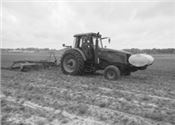Low Broadband Access Hinders Modern Producers

Most newer precision farming technology, such as irrigation programs that remotely show moisture sensor activity in real time, requires internet access and infrastructure that can handle large amounts of data.
File photo by MSU Extension Service/Kevin Hudson
MISSISSIPPI STATE, MISS.
From computer programs that regulate moisture sensors to smartphone apps that allow growers to monitor market data, most facets of agriculture continue their shift to digital platforms. This transition makes reliable internet access no longer a luxury, but a necessity.
Despite Mississippi agriculture’s annual economic impact of around $7 billion, broadband infrastructure is in short supply in the state’s densest agricultural hub: the 19-county Mississippi Delta.
Broadband is defined as internet access with download speeds above 25 megabits per second and upload speeds of at least 3 megabits per second. Brian Mills and Devon Meadowcroft, Extension agricultural economists based at the Mississippi State University Delta Research and Extension Center in Stoneville, compiled data that illustrate the limitations facing many counties and how the lack of broadband access creates significant disadvantages to growers wherever fast internet is scarce.
Their study used Federal Communications Commission broadband data and U.S. Census population statistics to examine farm employment and population with no broadband access in each of the state’s 82 counties.
They found that about 27 percent of Mississippians who live in rural counties lack broadband access. Nearly 60 percent of the state’s almost 3 million residents reside in rural counties and account for 80 percent of the state’s population without broadband. Only 17 counties were classified as urban based on USDA Economic Research Service definitions.
“Broadband internet takes a lot of infrastructure and up-front cost to install, and rural areas don’t get the same investment that more populated ones do,” Mills said. “Most newer precision farming technology, such as irrigation programs that allow you to see what your moisture sensors are doing in real time remotely, requires a lot of data. Without internet access, growers can’t find out this type of information as quickly as they would if they had it, and they lose out on potential profit.”
While nearly 20 percent of the state’s overall population lacks broadband access, Mills and Meadowcroft specifically examined the Delta after the relationship between the rate of farm employment and lack of broadband access became apparent. However, many areas in south Mississippi suffer from the same lack of resources.
Meadowcroft noted a prime example of this relationship in Issaquena County, which had both the highest farm employment rate (37 percent) and lowest percentage of population with broadband (4 percent).
“It’s good for policymakers to see what this situation currently looks like in Mississippi and look for ways to allocate resources toward bridging that gap,” she said. “Many people in rural populations need reliable internet just as much as those in suburbs and large cities. Agriculture is critical to the state’s economy, and one of the best ways we can support it is to find ways to get reliable internet access to our growers.”
Read their MSU Extension Service publication, Mississippi Agriculture Lacks Broadband Access, at
http://extension.msstate.edu/publications/mississippi-agriculture-lacks-broadband-access ∆